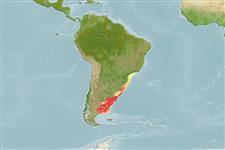Environment: milieu / climate zone / depth range / distribution range
Ecology
Marine; demersal; non-migratory; depth range ? - 100 m (Ref. 53324). Subtropical; 23°S - 48°S, 68°W - 41°W
Southwest Atlantic: Sao Paulo, Brazil to Golfo San Jorge, Argentina.
Size / Weight / Age
Maturity: Lm ? range ? - ? cm
Max length : 100.0 cm TL male/unsexed; (Ref. 27569); common length : 48.6 cm SL male/unsexed; (Ref. 27363); max. published weight: 10.0 kg (Ref. 27569)
Dorsal spines (total): 4 - 5; Dorsal soft rays (total): 24 - 27; Anal spines: 1; Anal soft rays: 22 - 24. Body pale brown with several dark brown vertical and horizontal stripes composed of dark brown blotches. A row of dark brown blotches on middle of dorsal fin membrane. An obvious black blotch on base of upper lobe of caudal fin (Ref. 27363).
Found on rocky and sandy bottoms in coastal waters (Ref. 53324). Oviparous with low batch fecundity (Ref. 53324). "We frequently catch P. semifasciata off the Rio de Janeiro coast. I have personally seen fish of 24 kg, with fish in the 12-18 kg range being fairly common (Capt. Eduardo Baumeier, pers. comm., 2001)." Ref. 27569 gave 10 kg as maximum weight.
Life cycle and mating behavior
Maturity | Reproduction | Spawning | Eggs | Fecundity | Larvae
Rosa, I.L. and R.S. Rosa, 1997. Systematic revision of the South American species of Pinguipedidae (Teleostei, Trachinoidei). Revta Bras. Zool. 14(4):845-865. (Ref. 27569)
IUCN Red List Status (Ref. 130435: Version 2024-1)
Threat to humans
Harmless
Human uses
Fisheries: commercial; gamefish: yes
Tools
Special reports
Download XML
Internet sources
Estimates based on models
Preferred temperature (Ref.
123201): 10.4 - 18.3, mean 14.5 °C (based on 176 cells).
Phylogenetic diversity index (Ref.
82804): PD
50 = 0.7500 [Uniqueness, from 0.5 = low to 2.0 = high].
Bayesian length-weight: a=0.00955 (0.00551 - 0.01656), b=3.03 (2.87 - 3.19), in cm total length, based on LWR estimates for this species & (Sub)family-body (Ref.
93245).
Trophic level (Ref.
69278): 3.9 ±0.68 se; based on food items.
Resilience (Ref.
120179): Low, minimum population doubling time 4.5 - 14 years (Assuming tmax>10).
Fishing Vulnerability (Ref.
59153): High vulnerability (60 of 100).
Climate Vulnerability (Ref.
125649): Very high vulnerability (88 of 100).
Nutrients (Ref.
124155): Calcium = 43.7 [28.8, 76.8] mg/100g; Iron = 0.844 [0.552, 1.288] mg/100g; Protein = 18 [16, 21] %; Omega3 = 0.323 [0.224, 0.462] g/100g; Selenium = 32.9 [18.3, 59.3] μg/100g; VitaminA = 9.2 [3.5, 23.7] μg/100g; Zinc = 0.584 [0.449, 0.797] mg/100g (wet weight); based on
nutrient studies.
